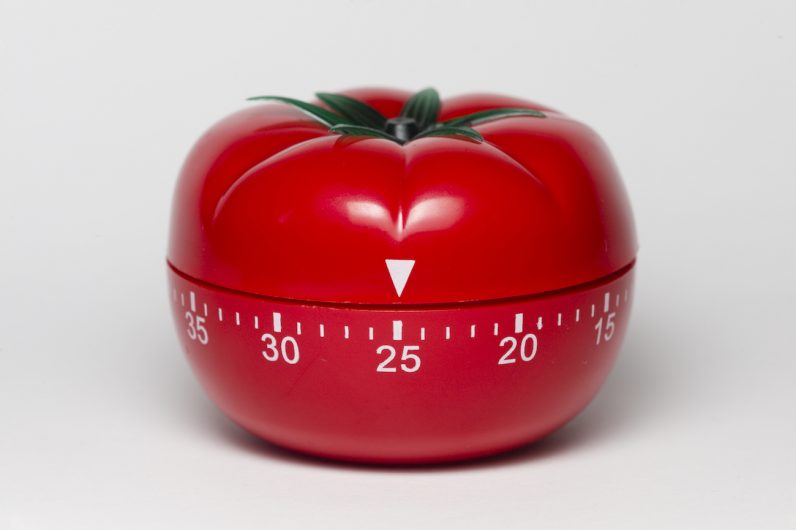Just like in fashion, you can see long-forgotten productivity fads return every few years, and even though it’s been around for a while, you’ve probably recently come across the hot new contender: the Pomodoro Technique. There’s just one problem with this latest productivity hack — my editor doesn’t quite get it, and appears to be too stubborn to read up on it to understand it. So let me answer a few of his ‘poignant’ questions and give you a low-down of this great productivity method. It’s no silver bullet but I saw quite a few people talk about it online recently, so I thought I’d give it a go. [Read: How to build a search engine for criminal data]
“What the hell does it have to do with tomatoes?!”
When I first brought this to my editor, he seemed very confused. As we are both working from home, he from Amsterdam and me from London, I had to make do with staring at his slightly bemused expression during one of our video calls. Understandably, he thought I’d gone off on a tangent and had decided to pitch him a story about eating spaghetti infused with tomato sauce in order to boost my productivity. I get the feeling neither of us is averse to pasta but I had to recover relatively quickly and explain that I was in fact talking about a well-established productivity method that just happened to be named after an edible berry. [Read: Why this security engineer loves working in infosec] ‘Pomodoro’ does mean tomato in Italian, but it refers to the tomato-shaped kitchen timer the technique’s creator, Francesco Cirillo, used. The timer is an essential part of the Pomodoro Technique, which Cirillo created in the late ‘80s during his university years. It’s a time management method based on 25-minute work intervals, that are then separated by a small break. Each interval is then called a ‘pomodoro’, referring to the tomato timer Cirillo had back in uni — cute, right?
“Hmm, fine — but what’s so good about it then?”
The beauty of the technique is in its simplicity. To stick to this time management technique, you only have to follow six basic steps:
Choose the task you want to tackle: This can be something big or simply something you’ve been wanting to do for a while. The only thing you need to bear in mind is that this task should get your full, undivided attention. Set the timer to 25 minutes and promise yourself that you’ll spend this time fully committed to this specific task. Work on the task until the timer rings. If for whatever reason you realize you need to do something else, write it down on a sheet of paper but avoid getting distracted. When the timer rings, cross your task off your list and pat yourself on the back for you’ve just completed your first ever pomodoro. Take a break. Once you’ve completed your task, take a short break. Don’t spend it at your desk, though, get up, walk around, grab yourself a drink. You get the idea. Once you’ve completed four pomodoros, you can take a longer break. Aim for either 20 or 30 minutes. Your brain will use this time to assimilate new information and rest before the next round of Pomodoros.
I have to be honest with you: I haven’t actually bothered to get myself a tomato timer. Shameful, I know. Instead, I’ve just given this a go using the stopwatch on my iPhone and by setting alarms every 25 minutes. But if that’s not doing it for you, there are also loads of online timers you can use. In my opinion, this method is appealing for several reasons. Firstly, it allows me to plan ahead, giving myself clear visibility on all the tasks I need to complete on a given day. Secondly, it means that I schedule regular breaks — and isn’t this what productivity experts always say one must do? Thirdly, I really like the idea of spending short bursts on a particular task or project. It makes the working day far less monotonous and actually helps me concentrate more effectively. More importantly, it’s given me yet another chance to get away from odious to-do lists, which in my opinion, are an unimaginative way to help one remember what needs to be done but do little in the way of prioritizing or incentivizing.
“Why is it trending now though? All my feeds are filled with tomato nonsense!”
I explained all of this to my editor and he finally seemed to get what I was going on about. He did, however, insist on knowing why this productivity method was now back in fashion. Indeed, it is strange that an old-time management technique is suddenly making a splash in our digitally-driven work lives — but in a way, I think it’s more needed now than ever before. Think about it: in many ways, technology has allowed us to work more effectively but it’s also increased the number of distractions we’re faced with every day. Whether it’s Slack, email, or social media, the truth is that we’re constantly having to fight to stay focused. I for one can’t tell you how many times an innocent tap on an Instagram notification has turned into hours of mindless scrolling. Our attention spans are getting shorter. This is why some people are so intent on doing digital detoxes or making a conscious effort to put down their smartphones during leisure time. So, what could be more effective, and poetic, than returning to good old fashioned analog methods in order to boost productivity? All hail the tomato. Do you have a preferred productivity method? Share your advice and experience with the Growth Quarters community.
